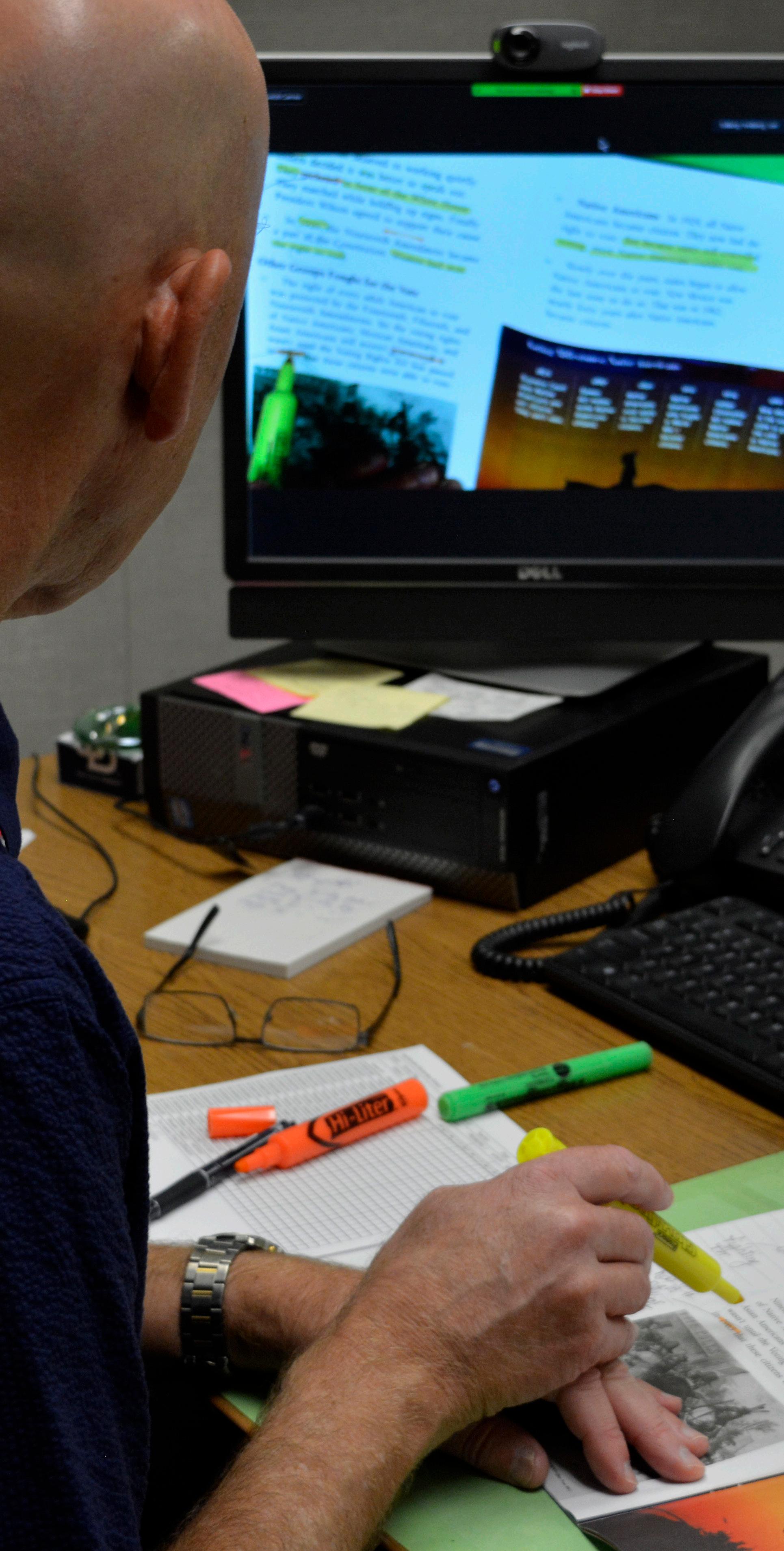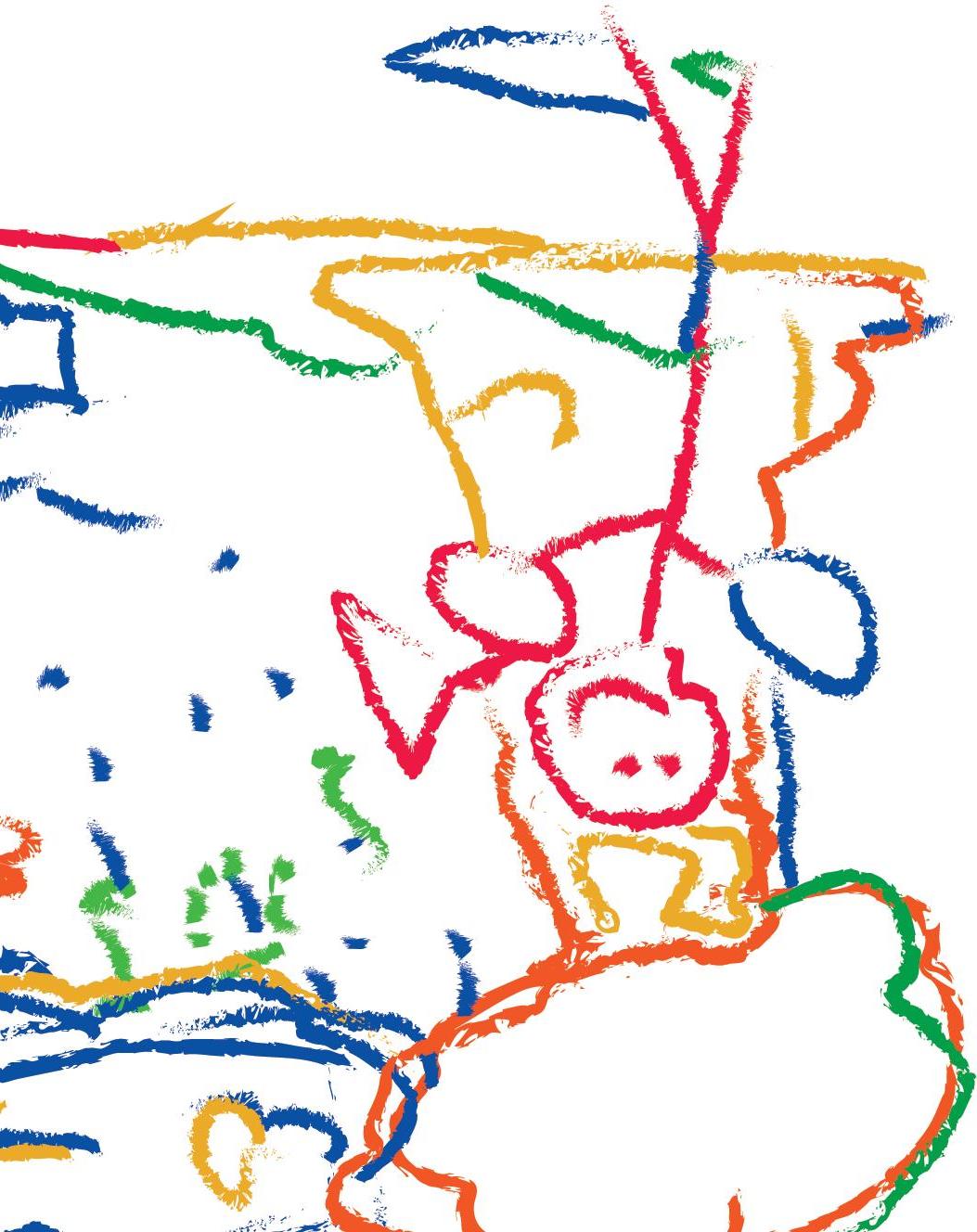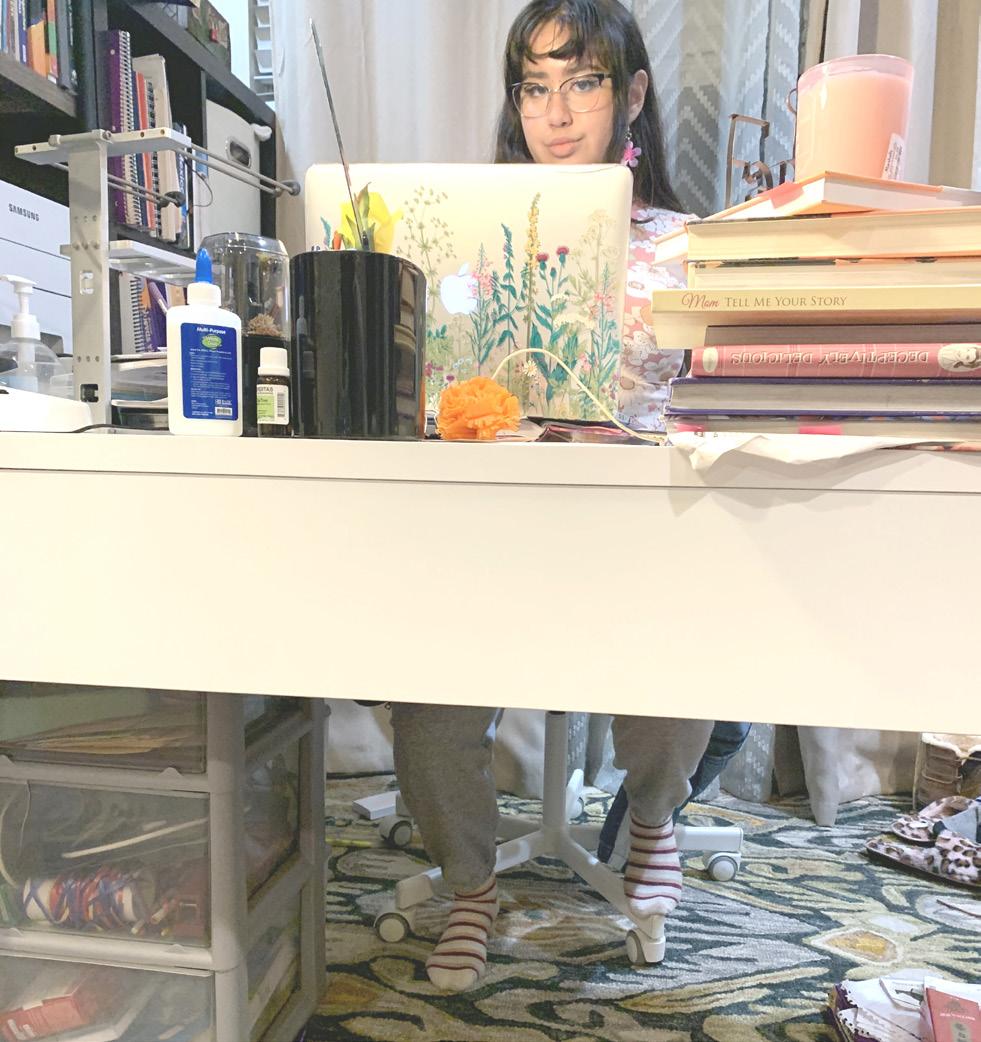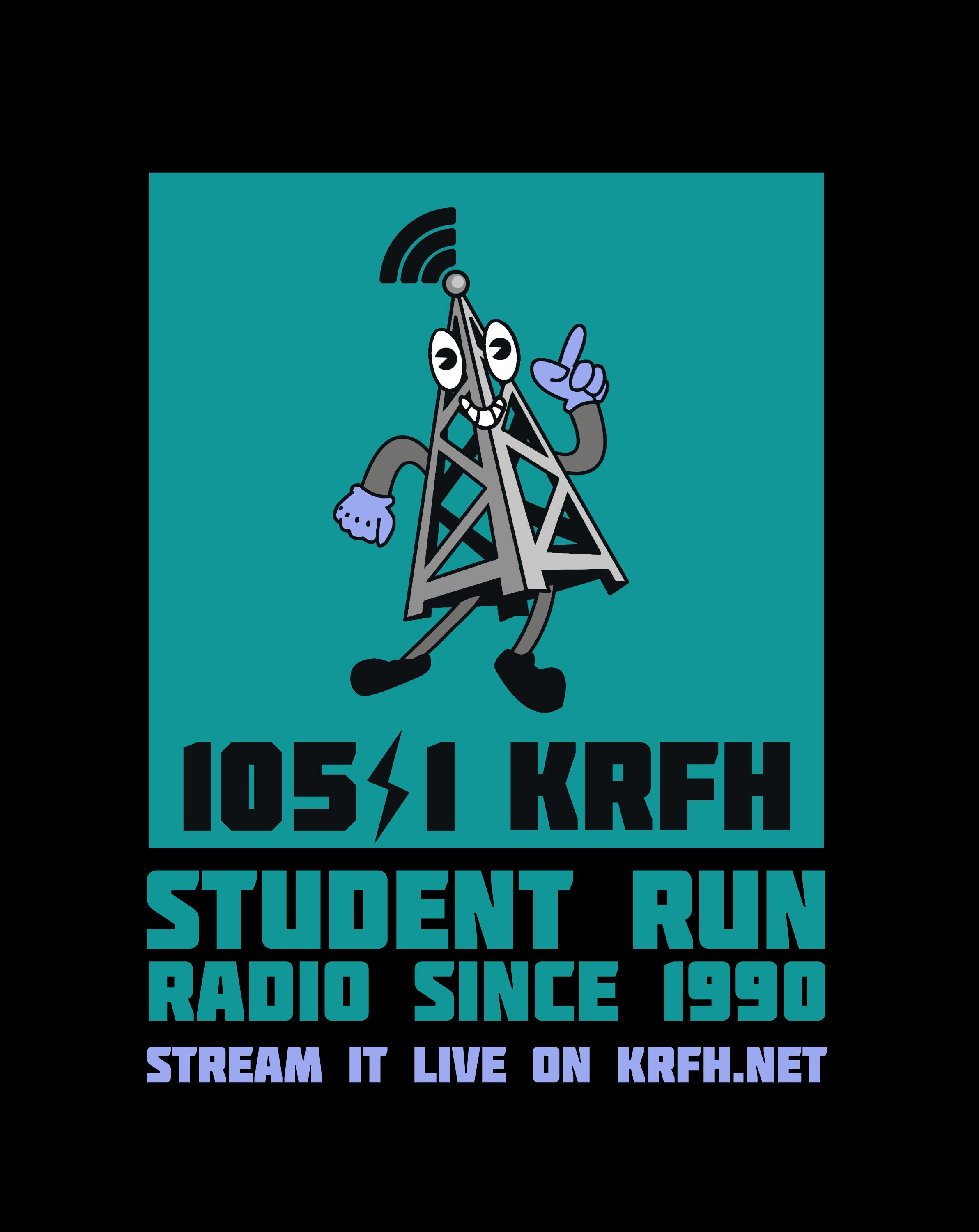
18 minute read
BEHIND THE ZOOM SCREEN: VIRTUAL CLASSROOMS IN THE CYBER AGE
from Osprey fall 2020
Behind the
Zoom Screen:
Advertisement
Virtual Classrooms in the Cyber Age
Story & Photos by Robin Freiberg
Joseph Freiberg sits alone at his computer teaching a math lesson to his class of 3rd grade students. Each child inhabits one of thirty different video boxes in the gallery view on his screen. In one of the little boxes in the upper right corner, Freiberg notices one of his students jumping up and down outside. The child is on a trampoline. “Josiah, where’s your mom?” Freiberg asked, clearly frustrated. Most people are well aware by now that the COVID-19 pandemic has been threatening the health of billions, leading schools across California to transition to an online format. Teachers from elementary to the collegiate level have had their careers completely change. With challenges of learning new online programs and connecting to students through the screen, teachers have adapted to the online world and are working hard to simulate the classroom environment to the best of their ability. Teachers across the spectrum, working in different subjects and with different age groups, are now faced with similar obstacles, beginning with their shift to the online learning spaces and adapting to new technology. After learning online platforms teachers are still finding it difficult to connect with students; however, a few months into the online school year, teachers have been led to a positive realization about themselves and their place in the uncharted territory they’ve been forced to navigate.


Overall, many teachers are staying follow a similar weekly schedule for Freiberg and Gallina were given positive and assimilating to the on- their students. This weekly struc- the opportunity to teach at their line, exemplifying the strength and ture invites the ability to copy and schools in empty classrooms, which compassion people can have when paste repeating information, which helps them separate work from faced with inevitable change. saves a lot of time that was spent home. With such a peaceful work Similar to students, teach- earlier in the year on the basics of space at school, Freiberg and Galliers have grown accustomed to Canvas. Humboldt State University na are able to better focus without using Zoom, a video conference English professor Janet Winston the distractions of pets and family program, and Canvas, a web-based includes an abundance of content members in their homes. Winston, learning management system. Un- for her classes. who works from home, expressed like students who showed up on the “I had used Canvas be- an out-of-the-ordinary distraction first day of school ready to learn, fore but never to the extent that that happened to her one morning: teachers spent endless hours train- I’m using it now by creating these a herd of cows loudly moo’d while ing over the summer and learning whole narratives every week for my passing outside her window as she how to navigate their platforms, students,” said Winston worked on Canvas. With the luxury while building their normally Whether on Canvas, in of staying in the quiet classroom, in-person classes from scratch. Ear- Zoom meetings, or responding Gallina even put together a spot ly in the school year, Freiberg was to take naps on her breaks with a surprised by the screen time data blanket and pillow set up in the his computer had collected. “I remember telling my “SOMETIMES, I’M corner of the room. Even with naps, Gallina is mentally and physically wife one day after school, ‘I’ve SITTING IN MY drained by the time she gets home. spent 391 hours on Canvas,” said Freiberg. CHAIR IN FRONT “It is utterly exhausting so I crash real early when I get home. Kurt Ruth, a high school P.E. and health teacher found himOF MY COMPUTER I get up very very early in order to get to school. So I’m in bed by 8:00 self online for hours at a time, re- FOR LIKE 14 OR 15 and up by 4:00am,” Gallina exwatching the same Canvas tutorials, unable to grasp the online platform. HOURS A DAY.” plains. John Byun, a choir conducEventually, he sought out support tor at Riverside City College, has from his colleagues to learn Canvas had an especially unique experience as a group. to emails, teachers spend most of teaching online, as directing a choir “I literally needed someone their days online. Sean Hausner is does not trans late well to virtual to take me through it where I could a teacher, bartender, and student, learning. With sound glitches and see it happening with step-by-step working on his teaching credential only being able to have one speaker visual instructions,” said Ruth. in high school chemistry. With both at a time on Zoom, singers canFor a physical education schooling and teaching, he is online not perform live together. Instead, teacher who normally teaches more than 10 hours a day. After his Byun has his students record their outside away from screens, Ruth work day online and at his part- singular parts and he mixes the rehas seen a major shift in his teach- time job, Hausner de-stresses with cordings together to create harmoing methods. He has students input videogames, which he admits is not nies. their exercise in fitness logs and the best way to get a break from “I was definitely not meant uses class time to discuss sports screens. to teach music technology that’s and health since he no longer has “Sometimes I’m sitting in for sure, that wasn’t my training. the ability to be physically present my chair in front of my computer It’s like a whole different job,” said during exercise activities. for like 14 or 15 hours a day,” says Byun. After becoming comfort- English professor Winston, who Although the transition able with their online platforms, finds herself in hyperfocus mode at to online has been an exhausting most teachers create an organized her home office. process, teachers are making the weekly template, allowing them to Elementary school teachers, best of it, feeling fulfilled and happy

to see their students. Interacting sense of community. Teachers have names as spectators, teachers feel with students both young and come up with creative strategies to as if they are talking to themselves. old is refreshing and uplifting to help students feel a connection to To bring back a sense of connection teachers. Without their jobs to keep the teacher and their classmates. to his audience, Hausner finds it them working toward a goal, the With her college students, Winston important to look at his chemistry pandemic would have been much utilizes class discussion. class as a group of individuals rathmore devastating. Even over video, “I’m implementing this idea er than a mass of boxes to lecture Gallina feels close to her 5th grade of the flipped classroom. I’m really at. class. asking students to “To build community “I have to keep focus- read and engage names are really important. I think ing on the fact that I’m doing this for the kids and I’m putting the kids first so my high is when I can see those kids’ faces and I come up with creative ways to keep them engaged and to keep them going,” said and make connections and watch everything before they come to class. Then what we do on Zoom is very student centered. The students are in JULIAN (GRADE 3) I THINK ONLINE LEARNING IS KINDA GOOD AND KINDA BAD. ONE WAY IT’S GOOD BECAUSE YOU GET TO STAY HOME ALL DAY AND YOUR DAY IS SHORTER, ONE WAY IT’S BAD BECAUSE YOU CAN’T SEE THE TEACHER IN PERSON AND YOU DON’T GET TO BE WITH THE CLASS ALL DAY. that’s what I’ve been learning is that you want to make sure you get everyones name right and call them out by their name as much as possible. Just so they’re acknowledged and they feel seen,” said Hausner. Engaging elementary school students requires a little more creativity. Children have a hard time sitting still and listening, and instead have to be regularly asked to accomplish a task in order to hold their attention. Gallina Gallina. breakout rooms creat- comes up with new fun activities Hausner ing slides to present to the other for her students every week. One of highlights what Zoom shows about students what they learned from the activities involved learning how students that the classroom does their independent reading and their to make a ‘pop’ sound with their not. conversations with each other,” said mouths after singing “The Lollipop “I think it’s fun when Winston. Song” by The Chordettes. Gallina students do show their screens, Zoom fails had students record themselves you know, sometimes they will be in the social aspect using a program called Flipsitting on their bed with their cat or like you see little posters behind them in their room and you kind of get a glimpse into their home life,” said Hausner. When asked what keeps her positive, Winston gives a heartfelt response. “I’m always positive. I do feel uplifted by teaching and by my students and so that even being on Zoom, the classroom makes me happy. I feel like my students are so of personal teacher and student connections. In the classroom setting teachers can pick up on physical indicators like a nod or a smile that helps show if a student understands or if the student grid in order to share their new skill with the class. Gallina’s newest classroom activity involves fitness. “I just came up with this thing called ‘Surprise ExerDAVID (GRADE 3) I KINDA LIKE IT AND KINDA DON’T LIKE IT BECAUSE, THE BAD NEWS IS , WE CAN’T PLAY WITH OUR FRIENDS AND THE GOOD NEWS IS WE DON’T HAVE MUCH TIME IN SCHOOL AND WE GET TO STAY HOME AND KISS OUR MOMS AND HUG OUR BROTHERS AND STUFF. compassionate with each other and is engaged. Without a re- cise’ which means with me,” said Winston. sponsive audience, teacher’s cannot when I call on a While teachers are fight- build off the energy of the students student they have to come up ing to maintain a positive out- in Zoom like they would in the with a warm-up exercise and lead look, something very important is classroom. Rather, when presented the class. It’s really difficult to get lacking in the online classroom: a with multiple black squares with kids motivated to get up from their

seats. So getting them to stand up and move around got the kids pretty excited. They were showing me things like Burpees and Jumping Jacks and I give them points if they can motivate all the other students to stand up and do it,” said Gallina. Teachers have utilized strategies to build community, yet they have come to the unfortunate conclusion that nothing comes close to an in-person setting. Technological glitches and the inability to observe their students or have chatter amongst the class are a few ways the classroom atmosphere is lost. Winston explains the limits of the screen. “I know there’s a lot of teaching philosophy and techniques about creating community online but I don’t think it can replace the face-to-face social aspects of learning,” said Winston. Hausner misses the little one-on-one conversations that are relationships through a Zoom call,” easily had in the classroom setting said Ruth. that build up trust Another aspect that is lost between the stu- is the easy ability to remind dent and teacher. Checking in with a student to ask how they are doing is one of the best ways to build up trust and keep a student on track. Ruth doesn’t even students of due dates and to check in with students who are falling behind. Sure, teachers can send emails and announcements, but notifications for emails and important messages are easily lost in MICHAEL (GRADE 3) I DISAGREE WITH JULIAN BECAUSE IT IS KINDA BORING CAUSE YOU DON’T GET TO SEE YOUR FRIENDS IN PERSON AND YOU DON’T REALLY GET TO SEE THE CLASSROOM. ALL WE HAVE TO SEE IS JUST YOU (FREIBERG) AND WHERE YOU SIT AND IT’S JUST BORING AND LAME. know what most of his the abyss of an inbox. students look like and would not Because of this, the recognize them if they were walk- responsibility of keeping track of ing down the street at his side. assignments has been enhanced “I think most of us are es- in an online setting. Doing work pecially into building relationships outside of class is another rewith students, you know, It’s very sponsibility that has grown. This difficult to build those really solid is especially noticeable in Byun’s

ALTA MURRIETA ELEMENTARY SCHOOL’S EMPTY PLAYGROUND ON FRIDAY MORNING

ALTA MURRIETA ELEMENTARY SCHOOL’S EMPTY PLAYGROUND ON FRIDAY MORNING

college choir class. their own. Winston agrees that her “They’re learning new students have to be more aware of things. They’re learning songs and their own schedule and deadlines, sight reading and the one-on-one juggling many classes and assignvoice lessons go well. So we are ments and having to keep track doing things but it’s just not “choir,” without as many it’s not a group of people coming together and making good sound together. They’re more training on their own to be a better musician and training to be a better singer. It’s a lot of individual assessin-class reminders from their professors. “I’m really looking at my students as agents in their own learning,” said Winston. This inabilAUDREY (GRADE 3) I LIKE ONLINE LEARNING CAUSE I CAN BE HOME ALL DAY AND AFTER THAT I CAN WATCH TV ALL DAY. ment and a lot of ity to verbally individual teaching,” remind students of upsaid Byun. coming assignments and having Winston has her students little to no power to monitor the prepare for class by reading and focus of students is an extremely looking at lecture material on debilitating obstacle at the elementary level. Young children are extremely dependent in their learning and without a teacher or parent beside them to keep them on track, elementary students are susceptible to falling behind in online learning. Annie Bush, mother of 6-year-old Raven Bush, was aware and concerned about this threat to her daughter’s primary education. Rather than letting Raven face the wrath of online learning, and having time to be home due to her jobs closing down from COVID-19, Bush decided to take the homeschool route. Bush expresses her concerns about public online schooling. “Sometimes a problem with public school, and no fault to the teacher at all, is that they’ve got 30 kids and you don’t know who’s going great in English and who’s failing at math and you try to put kids in boxes but it’s crazy, you know,

we all have different techniques of learning,” said Bush. After contacting the California Department of Education (CDE), Bush was able to pull her daughter from Lafayette Elementary School in Eureka CA and formed “Raven’s Nest School” consisting of just one 1st grade student, Raven. Bush trained herself to teach her daughter first grade, utilizing many websites including TimeforLearning.com and the CDE Core Concepts with the grade requirements, as well as many workbooks that help keep complete records of Raven’s achievements. Bush feels Raven is receiving a fuller, more personalized education and is excited about all the subjects she is teaching. “She’s getting art lessons, we just got done studying plant cells and the leaf structure so it’s pretty cool. I’m really enjoying it,” said Bush. Although she awaits the day when public school’s open again, Bush cherishes the moments she is spending with her daughter. “I’m watching my daughter do amazing stuff. A lot of parents don’t get to see what kids do at school and they don’t have that one-onone and it’s really beautiful to watch her blossom. I’m learning too at the same time,” said Bush. Bush expresses how Raven even surpasses her in different area. ”Now we’re learning Spanish together. It’s so cool how fast she’s absorbing it and she’s correcting me on my pronunciations which I love. Maybe by the end we’ll be halfway to fluent,” said Bush. Even though most parents are unable to homeschool their children and have kept their children in public online school, every parent has had their routines changed by having to keep their kids focused and on track sitting at their screens while learning at home. Freiberg and Gallina appreciate the extra efforts parents have been putting in. Amongst the learning of their new craft whether it be homeschool or public, the online experience has led teachers of all levels to take a step back from their individual lives and focus on the events in the world around them. Many of the teachers describe this change in their career as a humbling experience, having to be more flexible and empathetic to situations students have been put in. Winston’s heart goes out to the college students that were unable to join this year. “I’m very concerned about my students that aren’t here right now that have dropped out of college or can’t actually engage in the live sessions because they’re working two jobs or they’re taking care of a family member who is sick or their younger siblings so I worry about that. The digital divides and economic divides and racial divides are just heightened right now so that’s


what I’m missing in a sense that all the students at Humboldt State who want to be learning are not necessarily in our classrooms online right now,” said Winston. 2020 has taken many careers, homes, and families and turned them upside down. Our institutions have had to quickly react to the pandemic and no solution created feels the same. Rather than reminisce in the good old days of and complain about the failures of 2020, it is important to stay in the present and look at current affairs as a learning experience for a better future. Ruth embraces the abnormal. “People act like they expect it to be normal. Like, how can you expect it to be normal right now? This is something that hasn’t happened in our lifetimes. So, of course it’s going to be strange. Let’s go with it and make the best of it,” said Ruth. Every person tries their best to have an outlet for positivity among their struggles. Sometimes it is distraction through television or music, or chatting on the phone with a good friend. Teachers hope their classes are a safe space for students to stay in the present and enjoy little interactions with others in the same dire situation. Less rigorous elective classes especially serve as an escape from the stressful responsibilities students face. Byun uses his choir class as a safe outlet for his students to recharge before their more challenging classes. “I’m doing the best I can and I think the students are hanging on. I know some are stressed and some are not dealing well with the pandemic and hopefully I can be there for them and help them cope through this whole thing,” said Byun. Throughout 2020 and continuing into 2021, teachers have gone through an arduous digital journey of online teaching with much frustration and time spent online. This effort helped teachers build relationships through the screen that led them to adapt and overcome the current climate, spreading positivity and making the best of the situation. After looking into the lives of teachers across California who teach many different grades and subjects, there is a connecting feeling of compassion for their students. Teachers and students are learning to live in this online classroom together. Teachers with over 30 years of experience like Winston, Freiberg, and Byun were able to become students again by reforming their entire way of instruction, showing just how resilient our society can be. The effort and care teachers have put into the virtual classroom shows how selfless and community based they are and we owe it to them to return such efforts as students. As we all sit alone at our screens, connection online has become more meaningful than ever.
Something as simple as turning on your camera or asking how they’re doing might lift a teacher’s spirits. Online learning can often feel like a monotonous chore, but it is helpful to remember that our teachers love their jobs and are driven by their students even on a digital landscape.


osprey staff


BEHIND THE ZOOM SCREEN












